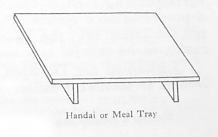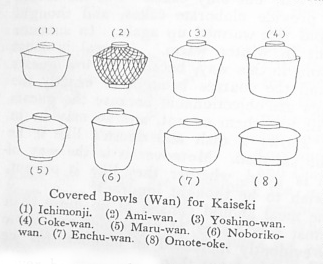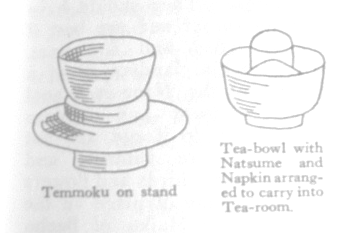ORDER OF MEAL
食
Kaiseki is the word used in Cha-no-yu for the light meal which is served.
懐石とは茶の湯において出される軽い食事のことです。
Literally it means " warming stone", the stone used in Zen monasteries to put in the breast in cold weather.
懐(ふところ)の石(いし)、文字の通り、禅の修業僧たちが懐に石を抱いて暖をとったことに由来します。
Then it came to mean a simple meal just sufficient to stay hunger, and so was borrowed by the Tea Masters.
空腹をみたすための簡素な食事という意味になり、茶人によって名ずけられました。
Originally in the Zen temple they had a table that was used by from two to four monks, but the Tea Masters Sho-o, Rikyu, and their contemporaries in the Daitouji preferred a small one for each person.
禅寺ではテーブルが使われていて、その内の大徳寺にて使われていたものを紹鵡、利休が茶の湯に懐石用のテーブルとして使いました。
(a) Serve principal dishes on tray. Retire and shut door of Mizuya.
(a)盆に載った主なお皿が運ばれます。 水屋口から退出します。
(b) Bring in either pickles or side dish ( hirazara) whichever is included.
(b)漬物もしくは小皿が運ばれてきます、同一の場合もあります。
(c) Change soup bowls.
(c)汁碗が出されます。
(d) Bring in Sake and pass cups round. Then take away bottle.
(d)お酒、杯が配られて、徳利は下げられます。
(e) Serve broiled fish or side dish if there is nene.
(e)焼き魚が出されますが、無い場合は小皿が出されます。
(f) Change the other bowl on the tray.
(f)盆の上の汁碗が換えられます。
(g) Hand Sake to chief guest. Here the host's assistant, should there be one, comes to the door of the Mizuya, makes a bow, retires and shuts the door.
(g)正客に酒が渡されます。このときは亭主の補助係りが一人もってきて、礼をして下がります。
(h) Serve soup course and take away side dish.
(h)汁が出され小皿が下げられます。
(i) Bring in Sake bottle and writing box and offer liquor again.
(i) 徳利が出され、八寸、酌が勧められます。
(j) Bring hot water. Take away soup bowl and shut door.
(j)お湯が運ばれ汁碗が下げられます。
(k) Take away trays, retire and shut door.
(k)飯台が下げられ戸がしまります。
(l) Bring cakes, retire and shut door.
(l)お菓子が運ばれ、下がり、戸がしまります。
Originally rice was not served, but only cakes.
元々は菓子だけでご飯は出されませんでした。
But the lovers of simplicity did not care to provide elaborate cakes, and thought it more convenient to serve cold rice wormed up again.
簡素をよしとする人達ですから、手の込んだ菓子をだすことは考えませんでした、そこで、ご飯を温めなおして出すことを思いついたのです。
In summer the dishes should be cold but in winter warm.
もちろん夏は冷たいままで、冬暖めたのです。
A meal is most enjoyable served in a small room in this way, because the few guests can be quickly attended to and the courses brought in exactly the right condition.
この方法による食事のもてなしは小さい部屋ではとても有効でした。多くない客たちはその食材を絶妙のタイミングで食することが出来たからです。
Strange things are objectionable because the guests do not know whether they will like them or not, and so may be in a quandary.
マイナスの部分があるとすれば、客が食材が分からすにいて、それが好みと好まざると出されるということです。困惑するかもしれません。
But if a guest knows a dish and doesn't like it he will leave it and so all will be satisfied.
嫌いな食材が出されたとしたら手を付けないでよける、そうすれば、その場はうまく行くでしょう。
Moreover it is way of people to say a strange dish is good, whether they like it or not, simply because they do not wish to be thought ignorant.
さらには、彼らは珍しい食材は大歓迎なのです。なぜなら、彼らは無知と思われることをけして望まないからです。
Rikyu considered that the meal should consist of no more than a bowl of soup, one, or at most two dishes of vegetables and some cakes.
利休は懐石料理は一汁に一か二菜、そしてお菓子でよいと言いました。
Later on the dishes evidently increased in number, for we find it stated that there should not be more than three soup or broth courses and five other dishes.
後になってもちろん品数は増えましたが三汁五菜を超えることはありません。
A good average is tow soup bowls and three other dishes, or one soup and three other courses.
普通は一汁三菜もしくは二汁三菜が良いです。
Cha-no-yu cookery should have no bones or fins or dishes that are difficult to eat or that cause any crunching with the teeth.
茶の湯の料理では、骨やヒレを使った歯でがりがり食べるなければならない料理はいけません。
There should be no sign of profusion, and anything startling or novel is not in good taste.
量は多くなく、驚かせたり奇抜なものは妙味では無いのです。
 The meal is served on plain wooden stands of the simplest shape with the edge of the wood only lacquered, called " Handai" or "Food-stand" and not "Zen" as usual.
The meal is served on plain wooden stands of the simplest shape with the edge of the wood only lacquered, called " Handai" or "Food-stand" and not "Zen" as usual.
料理は飯台と呼ばれる漆塗りの囲いも無い簡素な道具によって運ばれてきます、これは禅宗のものとは若干違います。
The bowls on it are of porcelain or celadon.
上に載せる器は磁器か青磁です。
Lacquered wooden bowls are not used.
漆器は使われません。
For the chop-stick, also of plain wood, a small rest is provided, since the stand has no rim.
箸も木製で小さな箸置きの上に置かれています。
They are placed on a paper napkin.
これらは紙ナプキンの上にしつらわれています。
There is an amusing work called "Shushoku Ron" or "The Agrement of Gourmand versus Drinkhard." The advocate for the case of the drinker is one Zoshu-no-Sho Kasuya Ason Nagamochi or Lord Stronghead Dreghouse of Bunghole Castle, Maltshire, and for that of the eater Hanshitsu Risshi Kohan or the Reverend Dean Trecherman Cakebread, the Arbiter being Chuzaemon no Taiyu Nakahara Cusei or Sir Gallio Middeton.
Shushoku Ronという書物があり、美食家と酒好きの議論がなされています。酒好方としてはZoshu-no-Sho Kasuya Ason Nagamochi 、 Lord Stronghead Dreghouse of Bunghole Castle, Maltshireが、美食家としてHanshitsu Risshi Kohan、 the Reverend Dean Trecherman Cakebread, the Arbiter being Chuzaemon no Taiyu Nakahara Cusei 、 Sir Gallio Middetonらが論を展開しています。
Katagiri Sekishu was famous for the elegance of his light repasts.
片桐石州は美食家として有名です。
When asked the secret he said: " If you begin by intending to prepare something light you will probably fail. You must prepare a large variety of things and from them select a few of the best. Then you will have a meal fit to give anyone."
誰かが彼に食のコツについて尋ねました。「もしあなたが完璧なものを出そうとすると、それは必ず失敗します。思いつく沢山のものを創り、その中からもっとも良いと思うものを選びなさい。さすればその食は美食になります」と言いました。
The guests on their part observe certain prescribed rules as the way of handling the bowls and their covers, sake cups, etc.
客にも食事作法があり、茶碗の扱いから食器、杯いたるまで決まり事を知っていなければならないのです。
There rules are devised with a view to facilitating the task of the host in serving and removing the trays and bowls with the least possible number of movements, and having them, when removed to the Mizuya, as clean and handy for washing up as may be.
これらの決まり事は亭主のまかないを円滑に進めることが出来るのです。飯台や茶碗の提供から、それらを水屋に下げた後の清掃までも範疇に入ります。
This is why it is not good to leave any food in the bowls.
すなわち、個の器の中に食べ残しは厳禁と言うことなのです。
There should be complete freedom for both host and guests, in that it is not necessary for the host to press the guests to eat, while they on their part can leave what they do not like without offence.
普通は客側が好きで無いものを残すことはある筈で、亭主や客の間では自由であるべきで無理強いはしてはいけません。
Only it is well that they make up their mind whether they will eat or leave any dish, and do not touch it unless they mean to finish it.
ただ一つの方法として食べないという意思表示は、最後までお箸を付けないことです。
For then it can be eaten by someone else and will not be wasted.
そうすれば、そのお皿は他の誰かが代わりに食べることができて、けして無駄にはなりません。
It is correct to finish the meal feeling somewhat unsatisfied.
いくぶん不満足ではありますが、これで食事は無事終わらせることが出来るのです。
 The Kaiseki ended, the guests go again to the Arbour to stretch their legs and smoke, after saluting hearth and the Tokonoma as on entering.
The Kaiseki ended, the guests go again to the Arbour to stretch their legs and smoke, after saluting hearth and the Tokonoma as on entering.
懐石料理が終わると、客はいったん待合へ下がり足を伸ばしたり煙草をすって休憩します。挨拶の後、亭主は炉と床の間の所作があります。
Here they wait till summoned by the sound of a gong.
客立ちは鐘の合図があるまで待っています。
Striking a gong to recall the guests comes from the custom of the Zen monastery.
客に合図するために鐘を鳴らすのは、禅の所作から来ています。
In the interval the host removes the Kakemono and substitutes a flower vase.
亭主は掛け物と茶花を換えます。
There is no special way of arranging the flowers in it.
花の生け方は特別な方法はありません。
They should be put in quite artlessly and there should never be more than two colors.
無作為自然に、そして花の色は二色を超えないようにしなければなりません。
Any flower or grass that has an unpleasant smell or that is not in season is inadmissible.
不快な香りやにおいの強すぎる草花はいけません、それに季節感の無いものも不可です。
Then follows first the serving of Koicha and then of Usucha and the inspection of the utensils and afterwards of their bags and boxes.
続いて、濃茶、薄茶、道具やそれを包む仕服などの拝見があります。
This over, they salute the host again and depart.
それが終わると、客は亭主に礼を言って、退出します。
Koichya was originally made with one bowl for each person, but as this took a long time and was tedious for the guests, Rikyu introduced the custom of passing the bowl round.
濃茶はもともとは一つの茶碗を亭主と客が双方やりとりするやり方をしていました。しかし、それではとても時間がかかってしまい他の客が飽きてしまいます。そこで、利休は茶碗を飲み回す方法を推奨し、それが所作として定着したのです。
Usucha came to be used later in the ceremony, partly because some did not like the strong variety and partly because Koicha alone did not quench the thirst.
薄茶は最後に振舞われますが、その理由はご苦労さまと濃茶だけでは喉がかわいてしますので清涼の役割があります。
Since, according to Rikyu, Koicha is to be regarded as the Finished Style, and Usucha, if taken after it, as Informal, the corresponding type of utensil should be sued.
利休の頃までは濃茶で終わるのが普通でした。薄茶は正式な茶事のの中には入れず、もし所望とあれば濃茶で使った道具で薄茶をたてていたのです。
But there should be a proper balance between them, lest the former be so exquisite as to put the latter into the shade, like a fine gentleman followed by a rustic, as he put it.
適切な均整がとれていなければならず、侘のなかにおいての正式性が憂慮され、田舎の紳士のごとく、薄茶は茶事の中へ組み込まれたのです。
Cha-no-yu for Daimyos and Imperial Abbots and Great Court Nobles is somewhat different from the ordinary.
大名や公家、そして高位役人はいくぶん普通とは違います。
It is always in the Finished Style.
それは常に洗練されたスタイルであるということです。
It may be called Highly Finished, perhaps.
多分、もっとも洗練されたと言うべきでしょう。
It is in accordance with their way of life.
生活そのものも含めてです。
 A six mat room or larger is proper with an ante-room for attendants.
A six mat room or larger is proper with an ante-room for attendants.
六畳のような大き目の部屋一つは、付沿人達の正式な待合室になっています。
The Daisu is used and the Water Jar and Ladle as well as the Furo are of metal.
台子というものと水指と柄杓、それに鉄の風炉と言う釜が使われますが、
The Kaiseki and Tea-making are carried out with the ceremony proper to Court Noble.
それらを含む懐石と茶の湯は宮殿へ儀式性をもって運ばれます。
But it did not follow that such personages were always treated thus.
そのような時、偉い人は自身で準備することはありません。
It was only when they were officially entertained.
彼らは接待のみを受るわけです。
In this case a hearth is never used; always a Furo and Daisu. And Tea is served in a Temmoku on a stand.
通常は風炉と台子が使われますが、炉を使用しない場合があります。そして天目台と言う道具をいます。
 Tenmoku Tea-bowls are so called from the mountain range of that name called in Chinese Tien-mu-shan.
Tenmoku Tea-bowls are so called from the mountain range of that name called in Chinese Tien-mu-shan.
天目茶碗は中国の山脈であるTie-mu-shanからその名前が付けられています。
It lies west of Hangchow and has two lakes on it whence the name " Heavenly Eyes Mountain."
この山はHangchowにあります。二つの湖があり、そのことから天の目の山と言われているのです。
On it is the famous Zen monastery of King-shan-ssu or Keizanji to which the monks from Japan went to study and where was the great priest Kyodo.
そこには有名な禅宗King-shan-ssuのお寺Keizanjiがあって、日本の禅僧Kyodoが勉強に行った所です。
Since they brought back Tea-bowls in which the Tea was there drunk before Daruma, this name stuck them, and as they were thus ceremoniously used they were set on the stand which always accompanies this type of Tea-bowl.
帰国のおりいくつかの茶碗を持ちかえり茶を飲んだ様で、それはDaruma大師より前には行われていました。このタイプの茶碗には台がくっついていて対になっていました。
They also have a rim of silver or gold because, as they were fired upside down resting on their mouth, this part was bare of glaze and therefore rough, and though later on the mouth also was glazed the rim continued to be used.
飲み口には銀又は金の縁取りがされていて、おそらく、くちあたりをよくするために施されたと思います。
Such guests are ushered into the reception room connected with the Tea-room with their two or three retainers, and their swords are deposited on the sword rack in the Tokonoma.
客達は茶室に隣接する応接間に案内をされ、そこには二三人の家人が共をしています。そして、彼らの刀は床の間の刀掛けに置かれます。
A guard of the host's retainers should be posted outside the outer gate of the Roji.
家来一人は露地戸の外にひかえていなければなりません。
The sandals of these important guests should be put by themselves, and not beside those of the host.
草履をそこで取り、守る役目があるのです。
The Tea-bowl and stand used should be new.
茶碗と天目台は新しいものを使わなければなりません。
Konoe Ozan once went to a Cha-no-yu with Sen Sotan, and though Sotan had a very proper appreciation of the high rank of his guest, for Ozan was then Kwanpaku, he yet entertained him in the Informal Style in a small Tea-room as usual.
関白Konoe Ozan という人物がSen Sotanの茶の湯に行くことになりました。Sotanは賢人に対して茶の接待にたけていると評判の茶人でした。Ozanはまだ一度も侘茶の接待を受けたことは無かったのです。
In the course of it Ozan inquired when the Tenmoku Tea-bowl on a stand was used, and Sotan explained that as old or interesting specimen might be used among equals, but that a new one was only used when entertaining guests of high rank.
茶事の中で天目茶碗が使われたのでOzanはその理由をただしました。すると、Sotanは新しい物は賢人たいして使わなければなりませんが、これは、それと同じものですが古いものであることを説明しました。
On Ozan asking what he meant by guests of high rank his host replied that people like himself should be so treated, but as he had come purposely to this humble Tea-room, and as he was know to be one enlightened in the real meaning of Tea, which does not regard rank, he had not departed from the ordinary simple ceremony.
Ozanは質問と続け、賢人に出したものを再びここで出したのはなぜなのか、しかも侘の茶室で故意に、茶の湯本来の意味を知っているはずである。この場所は身分は関係無い場所であると認識していると。
Sotan then asked him to step into the reception room adjoining, where he served Usucha in a Tenmoku on a stand.
Sotanは隣の応接間へ彼を促し、天目茶碗で薄茶をたてました。
Ozan admired his understanding and resource, which revealed the real value of Teaism.
Ozanは彼の機転と理解に感服しました、これこそ茶の湯の真髄なのです。
INTRODUCTION-1 TITLE CONTENTS